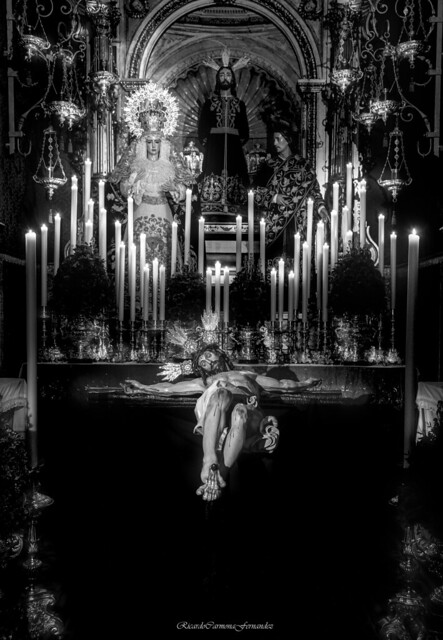La imaginería es una especialidad del arte de la escultura para la representación plástica de temas religiosos, por lo común realista y con finalidad devocional, litúrgica, procesional o catequética. Se vincula a la religión católica debido a su carácter icónico, por lo que la encontramos especialmente en países de cultura católica: España, Italia, Portugal e Iberoamérica y, en menor medida, Francia, Canadá, Países Bajos y Austria, así como también Filipinas.
La técnica más habitual es la talla en madera policromada buscando el realismo más convincente, a veces mediante vestidos y ropajes auténticos, o incluso añadiendo cabellos postizos.
La representación plástica de los misterios religiosos acompaña al Cristianismo desde sus primeros siglos, será con el arte románico y gótico, desde el siglo XII al XV, donde comience la evolución de la escultura en madera o imaginería, con fin catequético. Hasta el Renacimiento tienen mucha importancia los maestros flamencos y franceses. Sin embargo a partir del Concilio de Trento (1545-1563) la Iglesia católica, en respuesta a la Reforma luterana, decide potenciar las artes plásticas como medio de alcanzar la atención de los fieles, desarrollándose extraordinariamente la imaginería durante el periodo barroco en el área mediterránea, la península ibérica e Iberoamérica.
Recordando esta pasada Semana Santa sevillana sin procesiones en sus calles por la pandemia, visité algunas hermandades que exponian sus imágenes titulares al público y de diferentes maneras. En la fotografía el Santísimo Cristo del Mayor Dolor (Hermandad del Dulce Nombre), una escultura realizada en madera de cedro policromada, de 1,40 m de altura. Esta talla por sus caracteristicas se ha enmarcado dentro del estilo manierista sevillano. Obra anónima atribuida indistintamente a los escultores Juan Oviedo, El Mozo (1565-1625) y Andrés de Ocampo (1555-1653) Esta maravillosa talla se podia ver expuesta como muestra mi foto en la Parroquia de San Lorenzo (Sevilla). Captura realizada a pulso con iso alto y muy baja luz cuando me tocó mi turno para ponerme delante de este altar
(ENGLISH)
Imagery is a specialty of the art of sculpture for the plastic representation of religious themes, usually realistic and for devotional, liturgical, processional or catechetical purposes. It is linked to the Catholic religion due to its iconic character, which is why we find it especially in countries of Catholic culture: Spain, Italy, Portugal and Latin America and, to a lesser extent, France, Canada, the Netherlands and Austria, as well as the Philippines. . The most common technique is polychrome wood carving seeking the most convincing realism, sometimes through authentic dresses and clothing, or even adding false hair. The plastic representation of religious mysteries has accompanied Christianity since its first centuries, it will be with art Romanesque and Gothic, from the 12th to the 15th century, where the evolution of sculpture in wood or imagery began, with a catechetical purpose. Until the Renaissance, the Flemish and French masters were very important. However, from the Council of Trent (1545-1563) the Catholic Church, in response to the Lutheran Reformation, decided to promote the visual arts as a means of reaching the attention of the faithful, developing extraordinary imagery during the Baroque period in the area. Mediterranean, the Iberian Peninsula and Latin America.
Remembering this past Sevillian Holy Week without processions in its streets due to the pandemic, I visited some brotherhoods that exposed their titular images to the public and in different ways. In the photograph the Santísimo Cristo del Mayor Dolor (Hermandad del Dulce Nombre), a sculpture made of polychrome cedar wood, 1.40 m high. This carving, due to its characteristics, has been framed within the Sevillian mannerist style. Anonymous work attributed indistinctly to the sculptors Juan Oviedo, El Mozo (1565-1625) and Andrés de Ocampo (1555-1653). This wonderful carving could be seen on display as my photo shows in the Parish of San Lorenzo (Seville). Capture made by hand with high iso and very low light when it was my turn to stand in front of that altar
Cámara Nikon D850 con lente 24-120 F4/G-VR editada con Camera Raw y Photoshop CC 2019.
Recomiendo hacer doble click sobre la imagen y ver en grande.
I recommend see in larger, clicking double on the imagen.
 new
new

